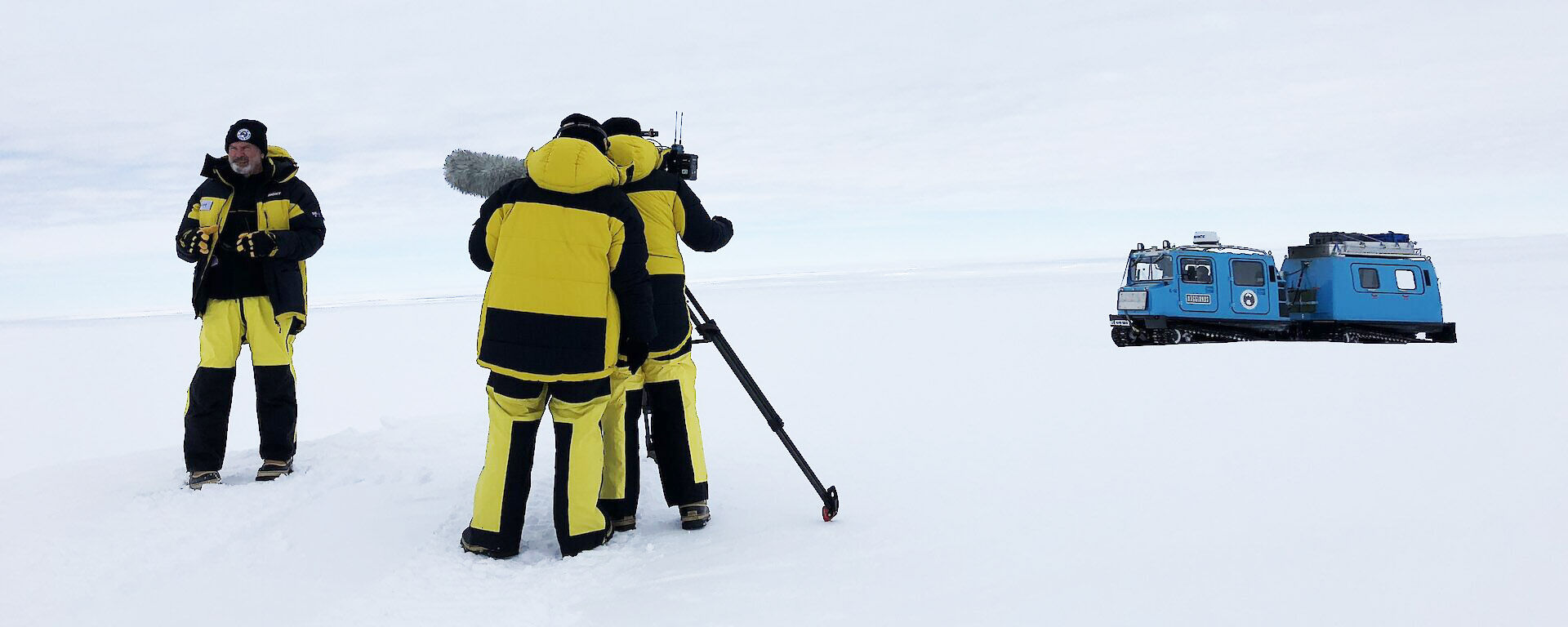Antarctic video gallery
Krill Matters
Video transcript
Text box: Scientists are voyaging into the Southern Ocean to measure Antarctic krill from all angles.
Text box: Using novel technologies they will estimate how much krill live in the waters off Mawson station.
Text box: Echosounders on RV Investigator can 'see' vast krill swarms under water and measure their 'biomass'.
Krill biologist – Rob King: So the principal method used in this voyage will be echo sounding the krill, and that's basically a glorified scientific fish finder. So we'll use those echo sounders to estimate the biomass of krill, that's how we measure it, but we also check that they really are krill by putting a net through these schools occasionally. And it also tells us about the type of krill that are in there, are they males, are they females, are they carrying eggs, what size are they. And all of this information refines our biomass estimate even further, and gives us much more confidence about that estimate.
Text box: For the first time, deep sea moorings will reveal how krill use the sea floor.
Rob King: There have been over 40 different occurrences now where krill have been recorded on the sea floor. Down as deep as three and a half kilometres deep. And we just don't know how important the seafloor benthic habitat is for krill. And if we're estimating biomass with an echosounder on the surface that can only see down 350 metres, how much of the population might we be missing all the way down to the sea floor?
Text box: The team will also study predators and ocean properties.
Text box: Their work will help set a precautionary catch limit for an expanding krill fishery.
Voyage Chief Scientist – So Kawaguchi: Setting precautionary catch limits, it's not only about krill biomass, but also understanding the relationship between the predators and the krill, and the environment. Because if you take too much krill, that may take too many krill for the food, for the predators, and that's the sort of thing that we really want to avoid.
Text box: The voyage will survey krill across more than 793,000 square kilometres.
So Kawaguchi: The last time that we surveyed in that area of Mawson coast is 2006, which is quite a long time ago, so we really have to update the understanding of that region so that we can, you know, update the precautionary catch limits and also the management strategy, to make sure that we have a good management system before the krill fisheries takes off again.
Text box: The research is critical to the sustainable management of krill and the predators that rely on them.
Rob King: Antarctic krill live in a unique environment, and they're perfectly adapted for it, but it's also one of the environments that is changing extremely fast with climate change at the moment. Laboratory research that we've done has shown that the acidification caused by dissolving carbon dioxide, has the potential to cause a 50% reduction in krill hatch rates by the end of this century if we did nothing to slow our carbon dioxide emissions. That would have a really important flow-on effect to biomass and how we managed the fishery. So understanding the environment, and the changes it can have on krill, is absolutely critical if we're going to manage this ecosystem to ensure the conservation of the species and those that depend upon it.
[end transcript]
Southward Bound
Video transcript
Charlton Clark, General Manager Operations & Safety, Australian Antarctic Division:
Today the MPV Everest, the icebreaker the Australian Antarctic Program is using for the 2020-21 season, departs from Hobart on a month long voyage to Casey station to conduct a resupply and transport expeditioners to Antarctica.
On board are more than 680 tonnes of cargo and a million litres of fuel to resupply Casey station for the year ahead.
The MPV Everest has an international crew with significant Arctic and Antarctic experience. They have the latest Polar Code training, and they’re operating one of the most highly capable and sophisticated ice-class vessels operating in Antarctica at the moment.
At 145 metres long, it gives a sense of the scale of Australia’s new icebreaker, the 160 metre long Nuyina.
The Everest is a state-of-the-art vessel, it’s equipped with the most comprehensive modern navigation equipment, safety equipment, it represents a real step-change from the Aurora Australis and really is closer to what we’re going to be experiencing in the future with the Nuyina coming online in seasons to come.
COVID-19 precautions include two weeks of isolation and three tests before boarding.
The Everest will not only be resupplying our stations, it’s also bringing back expeditioners who have been in Antarctica for over a year now, so people who will be coming back to a world that’s changed dramatically since they departed.
About 100 expeditioners will travel south and come home on MPV Everest this year.
I reckon anyone who’s going on a new ship is always going to be excited. Going to Antarctica is a special experience.
[end transcript]
Operation Tradies
Video transcript
"My name's Danielle McCarthy. I'm going to be down at Mawson station as Senior Observer with the Bureau of Meteorology."
"I'm Tom Jurs, I'm a carpenter heading south for the 2020 season... 2021 season."
"Being down south, we practice an isolated healthcare model so it's a single doctor model for each Antarctic station and as part of that we rely on our lay surgical assistants to assist us if we need to perform an operation."
"The scenarios that we run through together is a great chance to see how we each work individually, potentially what people's strengths and weaknesses are and how we can start that bonding with communication and also with the way we're going to work together in the future."
"As a lot of them are tradies or come from a scientific background they very quickly realise that a lot of the equipment that we use here or the just the way the body works, is similar to a lot of, you know, machines and plumbing that they might have come across already."
"They're really really good, really easy to teach. They absorb a lot and they learn so much in such a short amount of time."
"That's one of the reasons why the Centre for Antarctic Remote and Maritime Medicine has been set up here in Tasmania in collaboration with the Antarctic Division, because we really are a world centre of excellence when it comes to that medical training for remote and extreme environments."
"You'd have no usual business walking from a construction site into a hospital room and assisting with surgery. It's been incredibly stimulating and rewarding."
"That was a very good learning experience, a real life-type scenario and we covered a lot of points."
"It's one of the things that keeps me coming back during this course. It's really encouraging to see how excited and engaged they are with the process."
"I think they went absolutely brilliant. I've got every confidence that if we have to do any surgical or medical procedures for anybody, they're going to be in the safest hands possible. To see people from such diverse backgrounds stepping into a field that's so different for them and doing so with courage and confidence, is wonderful to see."
[end transcript]


